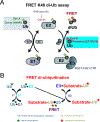Targeting Cullin-RING E3 Ubiquitin Ligase 4 by Small Molecule Modulators
- PMID: 34604860
- PMCID: PMC8486283
- DOI: 10.33696/Signaling.2.051
Targeting Cullin-RING E3 Ubiquitin Ligase 4 by Small Molecule Modulators
Abstract
Cullin-RING E3 ubiquitin ligase 4 (CRL4) plays an essential role in cell cycle progression. Recent efforts using high throughput screening and follow up hit-to-lead studies have led to identification of small molecules 33-11 and KH-4-43 that inhibit E3 CRL4's core ligase complex and exhibit anticancer potential. This review provides: 1) an updated perspective of E3 CRL4, including structural organization, major substrate targets and role in cancer; 2) a discussion of the challenges and strategies for finding the CRL inhibitor; and 3) a summary of the properties of the identified CRL4 inhibitors as well as a perspective on their potential utility to probe CRL4 biology and act as therapeutic agents.
Keywords: Cdt1; Cell cycle; E3 CRL4; Small molecule inhibitors; Tumor inhibition.
Conflict of interest statement
Competing Interest Statement R.J.D., Z.-Q.P., and K.W. are inventors on patent application 63/144,358 submitted by Icahn School of Medicine at Mount Sinai claiming inhibitors of Cullin-RING E3 ubiquitin ligase 4 (CRL4) to treat leukemia and other cancers.
Figures




Similar articles
-
Inhibitors of cullin-RING E3 ubiquitin ligase 4 with antitumor potential.Proc Natl Acad Sci U S A. 2021 Feb 23;118(8):e2007328118. doi: 10.1073/pnas.2007328118. Proc Natl Acad Sci U S A. 2021. PMID: 33602808 Free PMC article.
-
Modulation of Cullin-RING E3 ubiquitin ligase-dependent ubiquitination by small molecule compounds.J Biol Chem. 2024 Mar;300(3):105752. doi: 10.1016/j.jbc.2024.105752. Epub 2024 Feb 13. J Biol Chem. 2024. PMID: 38354780 Free PMC article.
-
CUL4B-deficiency in humans: understanding the clinical consequences of impaired Cullin 4-RING E3 ubiquitin ligase function.Mech Ageing Dev. 2011 Aug;132(8-9):366-73. doi: 10.1016/j.mad.2011.02.003. Epub 2011 Feb 23. Mech Ageing Dev. 2011. PMID: 21352845 Review.
-
Cullin-RING E3 ubiquitin ligase 4 regulates neurite morphogenesis during neurodevelopment.iScience. 2024 Jan 17;27(2):108933. doi: 10.1016/j.isci.2024.108933. eCollection 2024 Feb 16. iScience. 2024. PMID: 38318354 Free PMC article.
-
The structure and regulation of Cullin 2 based E3 ubiquitin ligases and their biological functions.Cell Div. 2016 May 23;11:7. doi: 10.1186/s13008-016-0020-7. eCollection 2016. Cell Div. 2016. PMID: 27222660 Free PMC article. Review.
Cited by
-
DCAF13 promotes ovarian cancer progression by activating FRAS1-mediated FAK signaling pathway.Cell Mol Life Sci. 2024 Oct 5;81(1):421. doi: 10.1007/s00018-024-05446-2. Cell Mol Life Sci. 2024. PMID: 39367995 Free PMC article.
-
Cul-4 inhibition rescues spastin levels and reduces defects in hereditary spastic paraplegia models.Brain. 2024 Oct 3;147(10):3534-3546. doi: 10.1093/brain/awae095. Brain. 2024. PMID: 38551087 Free PMC article.
References
-
- Petroski MD, Deshaies RJ. Function and regulation of cullin-RING ubiquitin ligases. Nat Rev Mol Cell Biol. 2005;6:9–20. - PubMed
-
- Li T, Chen X, Garbutt KC, Zhou P, Zheng N. Structure of DDB1 in complex with a paramyxovirus V protein: viral hijack of a propeller cluster in ubiquitin ligase. Cell. 2006;124(1):105–17. - PubMed
-
- Angers S, Li T, Yi X, MacCoss MJ, Moon RT, Zheng N. Molecular architecture and assembly of the DDB1-CUL4A ubiquitin ligase machinery. Nature. 2006;443(7111):590–3. - PubMed
-
- Rusnac DV, Zheng N. Structural Biology of CRL Ubiquitin Ligases. Adv Exp Med Biol. 2020;1217:9–31. - PubMed
Grants and funding
LinkOut - more resources
Full Text Sources
